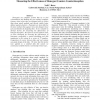Free Online Productivity Tools
i2Speak
i2Symbol
i2OCR
iTex2Img
iWeb2Print
iWeb2Shot
i2Type
iPdf2Split
iPdf2Merge
i2Bopomofo
i2Arabic
i2Style
i2Image
i2PDF
iLatex2Rtf
Sci2ools
HICSS
2006
IEEE
2006
IEEE
Measuring the Effectiveness of Honeypot Counter-Counterdeception
Honeypots are computer systems that try to fool cyberattackers into thinking they are ordinary computer systems, when in fact they are designed solely to collect data about attack methods and thereby enable better defense against attackers. Honeypots are more effective the more ordinary they appear, but so far designers have just used intuition in designing them. So it is valuable to develop metrics for measuring the effectiveness of honeypot deception. We report on several software tools we have developed for assessing the effectiveness of honeypots, particularly a metric-calculating tool that summarizes a file system by a vector of 72 numbers. Comparison of vectors between fake and real systems can guide design of the fake. We show that this metric tool, applied to a detailed fake file system we constructed, confirms that it is convincing in most ways.
Attack Methods | Biometrics | Enable Better Defense | HICSS 2006 | Honeypot Deception | System Sciences |
| Added | 11 Jun 2010 |
| Updated | 11 Jun 2010 |
| Type | Conference |
| Year | 2006 |
| Where | HICSS |
| Authors | Neil C. Rowe |
Comments (0)

